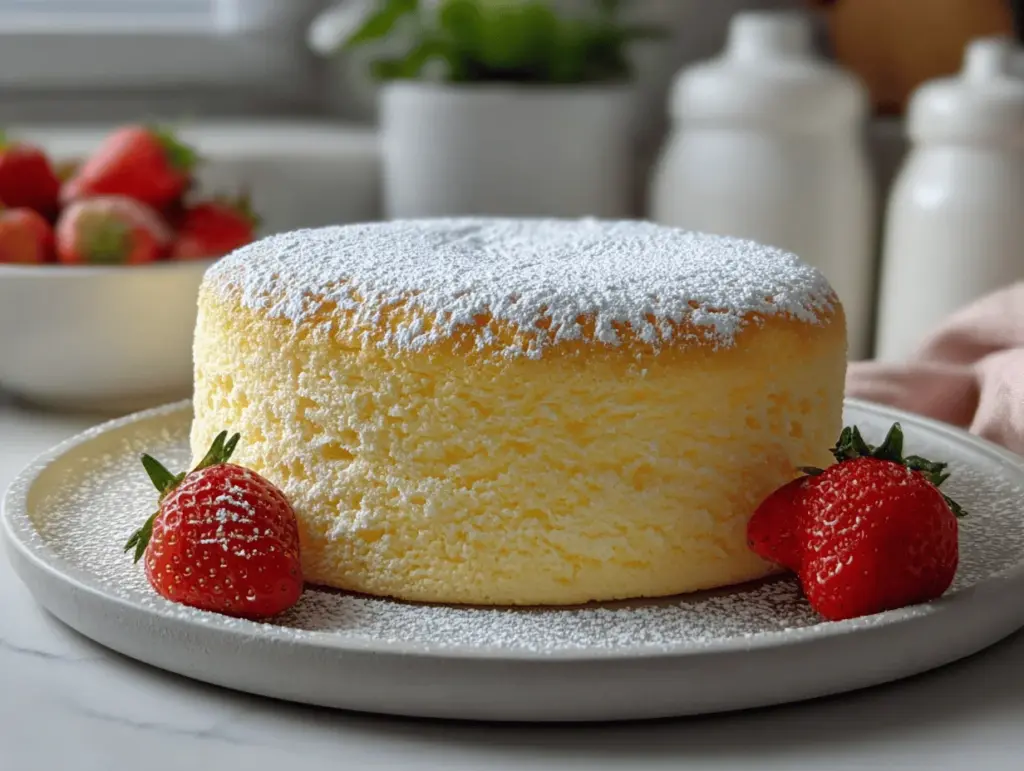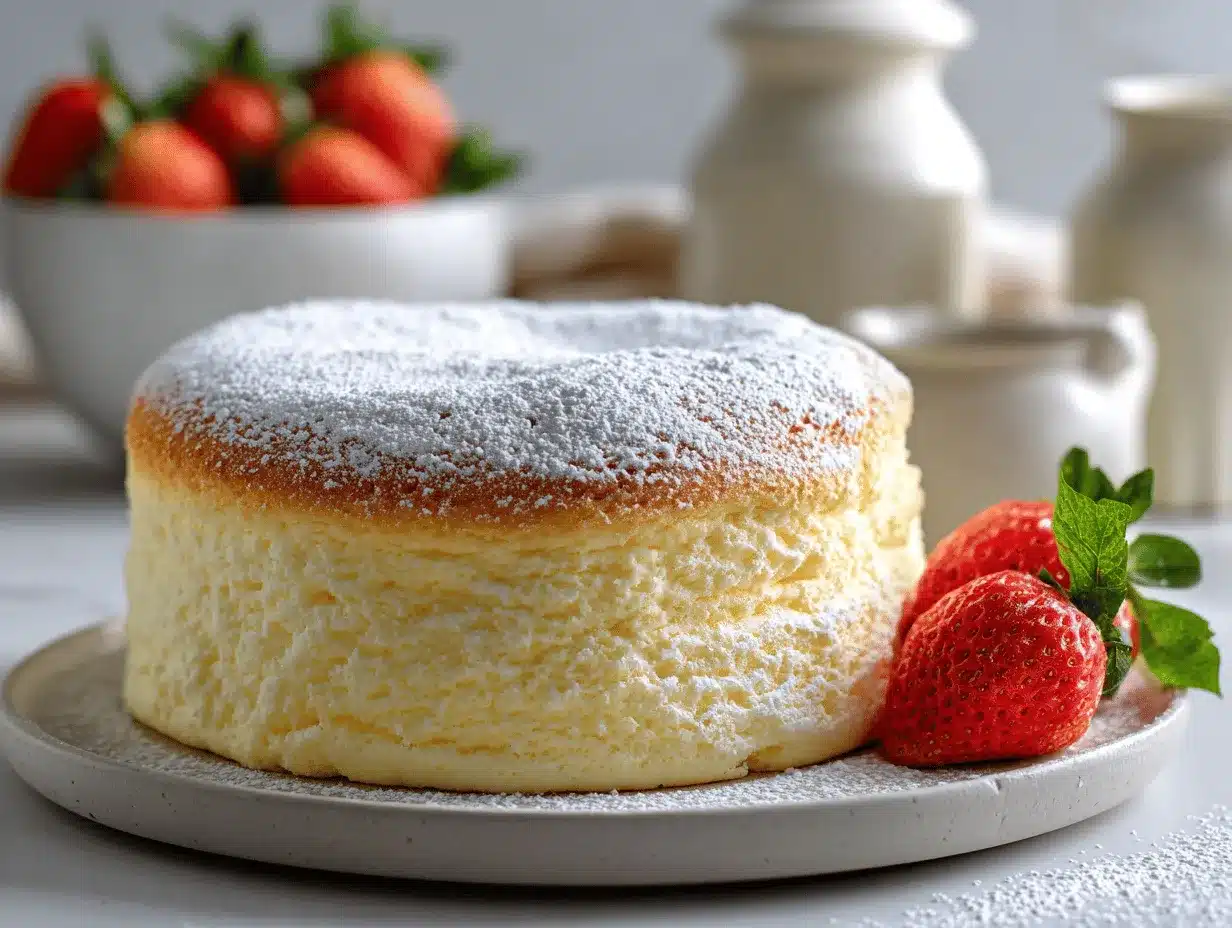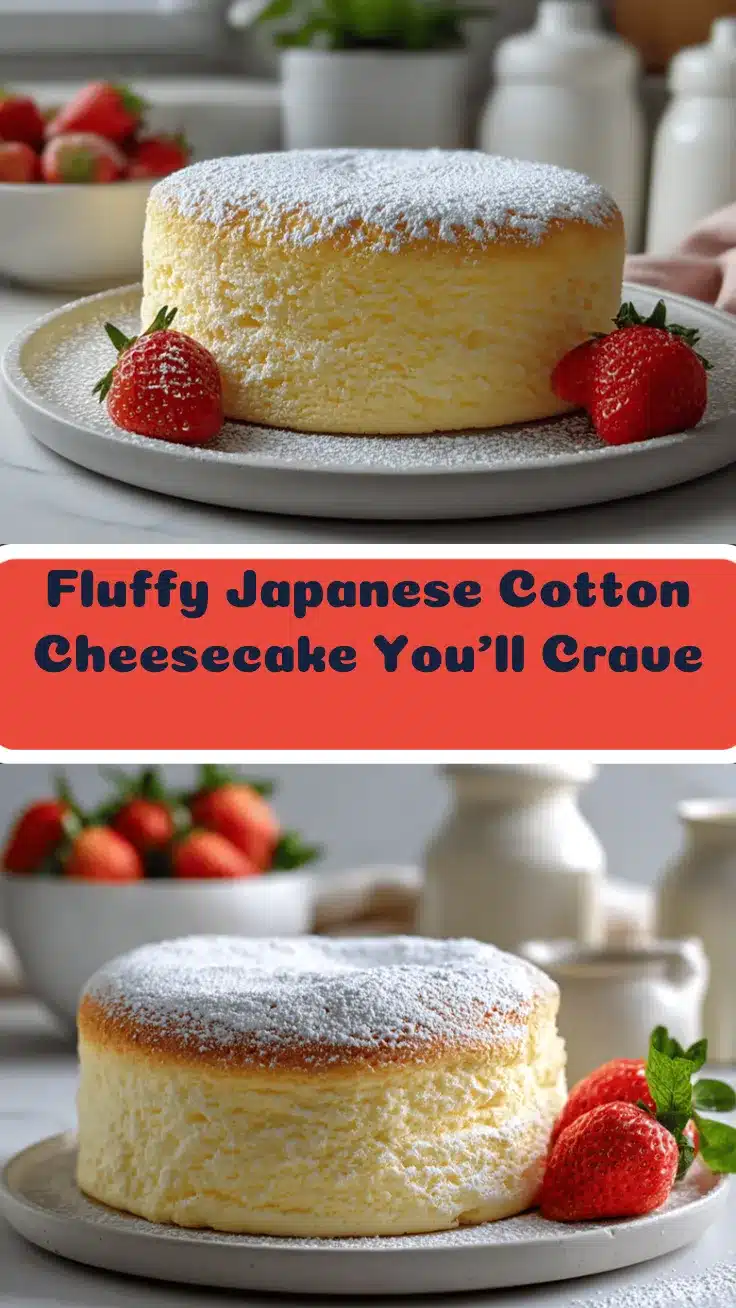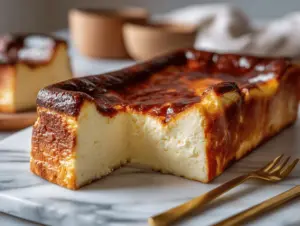The first time I tasted a slice of Japanese cotton cheesecake, I wondered if I’d ever eaten real cheesecake before. Picture this: it’s like biting into a cloud that’s barely sweet, with a whisper of tangy cream cheese and a melt-in-your-mouth finish that’s almost magical. The texture is so fluffy and airy, you can see the tiny bubbles inside—kind of like a soufflé, but with a familiar cheesecake richness.
I stumbled onto Japanese cotton cheesecake during a late-night YouTube binge, watching bakers whip up impossibly tall, wobbly cakes. You know those satisfying jiggle videos? Yep, that’s what got me hooked. My first attempt was a comedy of errors—egg whites everywhere, a leaky water bath. But after a few tries (okay, five or six!), I learned the little secrets that make this recipe foolproof.
Japanese cotton cheesecake isn’t just another dessert—it’s a cozy treat that feels special, even on a regular weeknight. If you’ve had classic New York-style cheesecake, imagine all the creaminess but with a lighter, almost ethereal texture. This recipe is perfect for anyone chasing that “wow” moment at family gatherings, or just wanting a slice of something not-too-sweet with afternoon tea. It’s surprisingly simple once you know the tricks, and it’s become my go-to for birthdays and holidays because it never fails to impress. I swear by this Japanese cotton cheesecake recipe after testing it a dozen times—so you can trust it’s both reliable and delicious!
Why You’ll Love This Recipe
- Quick & Easy: You’ll be surprised—this Japanese cotton cheesecake comes together in about 20 minutes of prep, and the rest is hands-off baking and cooling. Perfect for busy bakers or last-minute dessert plans.
- Simple Ingredients: No need for anything fancy. Cream cheese, eggs, sugar, and a couple pantry staples are all you need. I bet you have most of it right now.
- Perfect for Celebrations: Whether it’s brunch with friends, a birthday, or just a cozy night in, this fluffy cheesecake always gets those “How did you make this?” comments.
- Crowd-Pleaser: Kids love the light texture, adults appreciate how it’s not overly sweet, and honestly, it’s one of those desserts that disappears fast at gatherings.
- Unbelievably Delicious: The airy, souffle-like crumb is what sets this Japanese cotton cheesecake apart. It’s got that classic cream cheese flavor, but somehow feels lighter—a real treat for anyone who finds regular cheesecake a bit too rich.
What makes this recipe different? I use a few tricks: blending the cream cheese mixture until it’s silky-smooth, folding in whipped egg whites with a gentle hand, and baking low and slow with a water bath for that signature rise and jiggle. I’ve tested this method countless times, so you get consistent results—no more sunken middles or dense layers.
You’ll love how this Japanese cotton cheesecake brings comfort without heaviness. It’s the kind of dessert that makes you close your eyes and savor each bite. It’s also super flexible—dress it up with fresh berries, dust it with powdered sugar, or just eat it plain and enjoy the cloud-like goodness. Trust me, this is the best version you’ll ever make.
What Ingredients You Will Need
This Japanese cotton cheesecake recipe keeps things simple and wholesome. Every ingredient plays a part in building that dreamy, airy texture and subtle sweetness. Most are pantry staples, and substitutions are easy if you need them. Here’s what you’ll need:
- Cream Cheese (250g / 8.8 oz): Full-fat block style gives the best flavor and structure. I like Philadelphia for reliability, but any good-quality cream cheese works.
- Unsalted Butter (50g / 3.5 tbsp): Adds richness and helps with the smooth texture. Soften it for easier mixing.
- Whole Milk (100ml / 6.5 tbsp): Makes the batter silky and helps whip up that fluffiness. Room temperature is best.
- Egg Yolks (6 large): The secret to a creamy, custardy base. Use fresh eggs for maximum volume.
- Egg Whites (6 large): Whipped to stiff peaks—they’re the magic behind the cake’s signature airy lift.
- Cake Flour (60g / 1/2 cup): Gives a soft, fine crumb. All-purpose flour can work, but cake flour is best for true Japanese cotton cheesecake texture.
- Cornstarch (20g / 2.5 tbsp): Adds extra lightness and helps stabilize the batter.
- Granulated Sugar (120g / 2/3 cup): Divided—some for the yolk mixture, some for the meringue. You can adjust for sweetness.
- Lemon Juice (1 tbsp): Brightens up the flavor and helps stabilize the meringue.
- Vanilla Extract (1 tsp): Optional, but adds a lovely aroma. Use pure vanilla for best results.
- Salt (pinch): Balances the sweetness and brings out the flavors.
Substitution Tips:
- Dairy-Free: Try vegan cream cheese and plant-based butter for a dairy-free version. Almond milk works in a pinch.
- Gluten-Free: Swap cake flour with a gluten-free blend plus 1 tsp xanthan gum.
- Low-Carb: Use a sugar substitute like erythritol, though texture may change slightly.
Ingredient Notes: For the best Japanese cotton cheesecake, use room-temperature ingredients—they blend more easily and give a smoother batter. Fresh eggs whip up fluffier meringue. If you’re using store-brand cream cheese, check for stabilizers (sometimes they affect texture).
Equipment Needed
Making Japanese cotton cheesecake doesn’t require fancy gadgets, but having the right tools does make a difference. Here’s what I use every time:
- 8-inch (20cm) Round Cake Pan: Preferably with high sides. A springform pan works, but line it well to prevent leaks.
- Electric Mixer: Stand mixer or hand mixer—whipping egg whites by hand is possible but honestly, it’s a workout!
- Large Mixing Bowls: At least two—one for the cream cheese base, one for the meringue.
- Fine Mesh Sieve: For sifting flour and cornstarch. Keeps the batter lump-free.
- Spatula: Silicone works best for folding the meringue in gently.
- Parchment Paper: Line the pan and the sides to help with easy release.
- Baking Sheet or Roasting Pan: For the water bath—essential for fluffy, crack-free cheesecake.
- Measuring Cups and Spoons: Accuracy matters for perfect texture.
If you don’t have an electric mixer, a balloon whisk will work—just expect a good arm workout. I’ve used budget hand mixers for years before investing in a stand mixer, and they work fine. For the water bath, any oven-safe pan that fits your cake pan will do. Maintenance tip: always dry your mixing bowls thoroughly before whipping egg whites to prevent deflation.
Preparation Method
- Prep Your Pan: Line the bottom and sides of an 8-inch (20cm) round cake pan with parchment paper. Wrap the outside tightly with aluminum foil to prevent water from the bath seeping in. Preheat your oven to 320°F (160°C).
- Make the Cream Cheese Base: In a large bowl, combine 250g cream cheese and 50g unsalted butter. Microwave for 20-30 seconds or set over a bowl of hot water until both are softened but not melted. Whisk until smooth and lump-free. Add 100ml whole milk and whisk again until fully incorporated.
- Add Egg Yolks: Whisk in 6 large egg yolks, one at a time, mixing well after each addition. This creates a custardy texture. Stir in 1 tsp vanilla extract and a pinch of salt.
- Sift Dry Ingredients: Over the bowl, sift together 60g cake flour and 20g cornstarch. Gently fold into the cream cheese mixture until just combined. Don’t overmix—stop once you see no streaks of flour.
- Make Meringue: In a clean, dry bowl, whip 6 large egg whites until foamy. Add 1 tbsp lemon juice and beat until soft peaks form. Gradually add 120g granulated sugar, beating until stiff, glossy peaks form (about 5-7 minutes with a mixer).
- Fold Meringue: Add one-third of the meringue to the cream cheese batter and mix gently to lighten it. Then carefully fold in the remaining meringue with a spatula—use an under-and-over motion so you don’t deflate the air bubbles. The batter should be light and airy.
- Pour & Water Bath Setup: Pour the batter into your lined cake pan. Tap gently on the counter to release large air bubbles. Place the cake pan in a larger baking dish or roasting pan. Fill the outer pan with hot water to reach halfway up the cake pan sides.
- Bake: Bake at 320°F (160°C) for 25 minutes. Reduce the temperature to 280°F (140°C) and bake for another 50-60 minutes, or until the top is lightly golden and the cake jiggles but feels set when gently touched. (If your oven runs hot, tent with foil to prevent over-browning.)
- Cool Gradually: Turn off the oven and leave the cake inside with the door slightly ajar for 15 minutes—this helps prevent cracks. Remove, then cool completely at room temperature before unmolding.
- Unmold & Serve: Slide a small knife around the parchment edges, lift the cake out, and peel off the paper. Slice with a warm, dry knife for neat pieces. Enjoy your fluffy Japanese cotton cheesecake!
Troubleshooting Tips: If the cake sinks or cracks, it’s usually from overmixing or sudden temperature changes. Always fold gently and cool gradually. If the meringue won’t whip, make sure your bowl is grease-free. Sensory cues: the batter should look pale, thick, and airy; the baked cake will have a barely golden top and a soft, wobbling center.
Personal tip: If you’re in a hurry, you can cool the cake in the fridge after 30 minutes at room temp, but flavors develop best if you let it sit for a few hours.
Cooking Tips & Techniques
After dozens of Japanese cotton cheesecake bakes (and more than a few flops!), I’ve picked up some tricks you’ll want to keep in your back pocket.
- Egg White Wisdom: Always use room-temperature eggs—they whip up fluffier. If you get even a drop of yolk in your whites, start over. I learned the hard way; meringue just won’t form.
- Folding Matters: Use a wide spatula and fold gently. Overmixing deflates the air and gives you a dense cake. Less is more here—stop when the batter is just blended.
- Water Bath Magic: Water baths aren’t optional for this recipe. They keep the heat gentle and moist, so your Japanese cotton cheesecake rises evenly and stays soft. If your pan leaks, wrap it in double foil.
- Temperature Control: Gradual cooling is key. I used to rush and cool it fast—cracks every time! Let the cake rest with the oven door ajar to avoid sudden drops.
- Consistency Tips: Sift your dry ingredients—lumps ruin the texture. If your batter feels heavy or chunky, keep whisking until smooth before adding the meringue.
- Multitasking: Prep your water bath while whipping egg whites, and have your pan lined before you start. Saves time and keeps things stress-free.
Common mistakes include greasy bowls for meringue or forgetting the water bath. If you’re new to cheesecake, don’t worry—every mistake is a learning moment. My first cake came out flat and chewy, but every bake since has gotten fluffier. Trust the process!
Variations & Adaptations
Japanese cotton cheesecake is like a blank canvas—you can switch up flavors and textures to suit your style or dietary needs. Here are some favorite spins:
- Matcha Cotton Cheesecake: Add 2 tbsp high-quality matcha powder to the dry ingredients for a vibrant green color and earthy flavor. I love this version with a dusting of powdered sugar and fresh strawberries.
- Chocolate Swirl: Melt 60g (2 oz) dark chocolate and swirl it into half the batter before pouring into the pan. Gives a marbled look and richer taste.
- Gluten-Free: Substitute cake flour with a gluten-free blend plus 1 tsp xanthan gum. The texture will be slightly different but still airy.
Cooking Methods: If you don’t have an oven, try steaming in a covered pan over low heat for 65-75 minutes. You’ll get the same soft texture without browning.
Flavor Customization: Swap vanilla for almond or coconut extract, or add orange zest for citrus notes. For ultra-light sweetness, reduce sugar by 20g (about 2 tbsp)—I’ve done this for friends who prefer less sugar and it’s still delicious.
Allergen Substitutions: Dairy-free versions work with vegan cream cheese and plant-based milk. Egg-free? Try an aquafaba meringue, though texture will be different.
My personal favorite: strawberry cotton cheesecake—fold in 100g (3.5 oz) chopped fresh strawberries before baking. It’s juicy, sweet, and looks beautiful sliced.
Serving & Storage Suggestions
This Japanese cotton cheesecake shines when served slightly chilled or at room temperature. The texture is soft and moist, so don’t worry about it feeling dry.
- Presentation: Dust with powdered sugar or top with whipped cream and fresh berries for a festive look. For a minimalist style, slice and serve as-is—the golden top and fluffy crumb are gorgeous on their own.
- Complementary Dishes: I like pairing with green tea, coffee, or a light fruit salad. If you’re serving for brunch, try with a side of smoked salmon toast—it sounds weird, but the contrast is amazing.
- Storage: Store leftovers in an airtight container in the fridge for up to 4 days. The flavor actually deepens after a day, and the cake stays moist.
- Freezing: You can freeze slices wrapped tightly in plastic and foil—just thaw in the fridge overnight before serving.
- Reheating: For a warm treat, microwave slices for 10-15 seconds. (Don’t overdo it or you’ll lose that airy texture!)
Flavor tip: The cheesecake tastes best after chilling for a few hours—the soft tang and subtle sweetness develop. Honestly, it’s even better the next day (if you have any left!).
Nutritional Information & Benefits
Japanese cotton cheesecake is lighter than classic cheesecakes, both in texture and calories. Here’s a rough breakdown per slice (based on 12 servings):
- Calories: 185 kcal
- Protein: 5g
- Fat: 10g
- Carbs: 19g
- Sugar: 12g
Health Benefits: The recipe uses less sugar and fat than traditional cheesecakes, and eggs provide quality protein. Cream cheese adds calcium, while cornstarch and cake flour keep things light.
Dietary Notes: This recipe is nut-free and can be adapted for gluten-free or dairy-free diets. Contains eggs and dairy—careful if you’re allergic!
From a wellness perspective, Japanese cotton cheesecake is a great way to satisfy dessert cravings without feeling too heavy. I love that you can enjoy a slice with tea and still feel energized afterward.
Conclusion
If you’re looking for a dessert that’s impressive, light, and genuinely satisfying, this Japanese cotton cheesecake recipe is a must-try. The airy texture and gentle sweetness make it a crowd favorite, whether it’s for birthdays, holidays, or just a sweet pick-me-up.
Customize it with matcha, chocolate, or fruit—make it your own! I keep coming back to this recipe because it’s reliable, flexible, and always delicious. There’s something about the soft, jiggly crumb that just makes people smile.
I hope you give this Japanese cotton cheesecake a shot—let me know how it turns out for you! Leave a comment with your tweaks, share your pictures, or tag me on Pinterest if you try a new flavor. Honestly, baking should be fun and a little bit magical—so go ahead, make your kitchen smell amazing!
FAQs
How do I prevent my Japanese cotton cheesecake from cracking?
Cool the cake gradually with the oven door slightly open. Sudden temperature changes cause cracks, so resist the urge to rush!
Can I make Japanese cotton cheesecake without a water bath?
The water bath helps keep the cake moist and fluffy. If you skip it, the texture might be drier and less airy, and you could get cracks.
What’s the best way to whip egg whites for this recipe?
Use clean, grease-free bowls and beat at medium speed until stiff, glossy peaks form. Room-temperature eggs work best.
Can I freeze Japanese cotton cheesecake?
Yes! Wrap slices tightly in plastic and foil, freeze for up to 2 months. Thaw overnight in the fridge before serving.
How do I know when the cheesecake is done baking?
The top should be lightly golden, and the cake should jiggle (like jelly) but feel set when gently pressed. If unsure, insert a toothpick—it should come out clean.
Pin This Recipe!
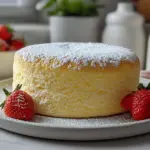
Japanese Cotton Cheesecake
- Total Time: 1 hour 45 minutes
- Yield: 12 servings 1x
Description
Japanese cotton cheesecake is a light, fluffy, and airy dessert with a subtle cream cheese flavor and a melt-in-your-mouth texture. It’s less sweet and rich than classic cheesecake, making it perfect for celebrations or a cozy treat with tea.
Ingredients
- 8.8 oz (250g) full-fat cream cheese, room temperature
- 3.5 tbsp (50g) unsalted butter, softened
- 6.5 tbsp (100ml) whole milk, room temperature
- 6 large eggs, separated
- 1/2 cup (60g) cake flour, sifted
- 2.5 tbsp (20g) cornstarch, sifted
- 2/3 cup (120g) granulated sugar, divided
- 1 tbsp lemon juice
- 1 tsp vanilla extract (optional)
- Pinch of salt
Instructions
- Line the bottom and sides of an 8-inch round cake pan with parchment paper. Wrap the outside tightly with aluminum foil to prevent water from the bath seeping in. Preheat oven to 320°F (160°C).
- In a large bowl, combine cream cheese and butter. Microwave for 20-30 seconds or set over a bowl of hot water until softened but not melted. Whisk until smooth and lump-free. Add milk and whisk until fully incorporated.
- Whisk in egg yolks, one at a time, mixing well after each addition. Stir in vanilla extract and salt.
- Sift cake flour and cornstarch over the bowl. Gently fold into the cream cheese mixture until just combined. Do not overmix.
- In a clean, dry bowl, whip egg whites until foamy. Add lemon juice and beat until soft peaks form. Gradually add sugar, beating until stiff, glossy peaks form (about 5-7 minutes).
- Add one-third of the meringue to the cream cheese batter and mix gently to lighten. Carefully fold in the remaining meringue with a spatula using an under-and-over motion.
- Pour batter into the lined cake pan. Tap gently on the counter to release large air bubbles. Place the cake pan in a larger baking dish or roasting pan. Fill the outer pan with hot water to reach halfway up the cake pan sides.
- Bake at 320°F (160°C) for 25 minutes. Reduce temperature to 280°F (140°C) and bake for another 50-60 minutes, or until the top is lightly golden and the cake jiggles but feels set when gently touched.
- Turn off the oven and leave the cake inside with the door slightly ajar for 15 minutes. Remove and cool completely at room temperature before unmolding.
- Slide a small knife around the parchment edges, lift the cake out, and peel off the paper. Slice with a warm, dry knife for neat pieces. Serve and enjoy!
Notes
Use room-temperature ingredients for best texture. Always fold meringue gently to avoid deflating the batter. Water bath is essential for a moist, crack-free cake. Cool gradually to prevent cracks. For gluten-free, substitute cake flour with a gluten-free blend plus 1 tsp xanthan gum. Dairy-free versions work with vegan cream cheese and plant-based milk. Store leftovers in the fridge for up to 4 days or freeze slices for up to 2 months.
- Prep Time: 20 minutes
- Cook Time: 75-85 minutes
- Category: Dessert
- Cuisine: Japanese
Nutrition
- Serving Size: 1 slice (1/12 of cake)
- Calories: 185
- Sugar: 12
- Sodium: 120
- Fat: 10
- Saturated Fat: 6
- Carbohydrates: 19
- Protein: 5
Keywords: Japanese cotton cheesecake, fluffy cheesecake, airy cheesecake, jiggly cheesecake, light cheesecake, Asian dessert, birthday cake, holiday dessert, easy cheesecake, water bath cheesecake
